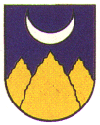Roche-d'Or
| Roche-d'Or | ||
|---|---|---|
| State : |
|
|
| Canton : |
|
|
| District : | Porrentruy | |
| Municipal municipality : | Haute ajoie | |
| Postal code : | 2912 | |
| former BFS no. : | 6802 | |
| Coordinates : | 563513 / 246564 | |
| Height : | 842 m above sea level M. | |
| Area : | 3.46 km² | |
| Residents: | 38 (December 31, 2007) | |
| Population density : | 11 inhabitants per km² | |
| map | ||
|
|
||
Roche-d'Or (French [ ʀɔʃdɔʀ ], in local dialect [ (a) ruɛʤ doɛ ]; German Goldenfels ; medieval Latin Rupes Aurea ) is a village with castle ruins and a formerly independent municipality in the district of Porrentruy in the Swiss canton of Jura . It has been part of the Haute-Ajoie municipality since 2009 .
geography
Roche-d'Or is 842 m above sea level. M. , eleven kilometers southwest of the district capital Porrentruy (linear distance ). The small farming village extends in a panoramic position on a ridge of the Jura chain of the Lomont , in the southwest of the Ajoie (German Elsgau ).
The 3.5 km² large former municipal area covers a section of the ridge of the Lomont range, which separates the Ajoie in the north from the Doubs valley in the south. The highest point of Roche-d'Or is on the 927 m high panoramic mountain Faux d'Enson . There is an observation tower from which you can see the whole region. In the south-west the area extends into a northern side valley that slopes rapidly towards the Doubs. In 1997, 3% of the municipal area was accounted for by settlements, 42% for forests and woodlands and 55% for agriculture.
Roche-d'Or includes the Vacherie-Dessus farm estate ( 865 m above sea level ) at the height of the Lomont chain and several individual farms. Neighboring towns of Roche-d'Or are Réclère , Grandfontaine , Rocourt and Chevenez in the canton of Jura and Vaufrey and Glère in neighboring France .
population
Since the middle of the 19th century the population of the place has decreased significantly:
- 1818: 91 inhabitants
- 1850: 128 inhabitants
- 1900: 77 inhabitants
- 1950: 74 inhabitants
- 2000: 33 inhabitants
- 2007: 38 inhabitants
With 38 inhabitants (at the end of 2007), Roche-d'Or was the smallest municipality in the canton of Jura before the merger. Of the 33 residents in 2000, 29 (87.9%) were French-speaking and four (12.1%) were German-speaking.
Because of the dwindling population, the school was closed in 1977.
economy
Roche-d'Or is an agricultural village, with livestock and dairy farming predominant. The place hardly offers any jobs outside of the primary sector. The few people who are not employed in agriculture work mainly in the Porrentruy region .
traffic
Roche-d'Or is off the main thoroughfare. From the cantonal road that runs from Porrentruy over the border crossing from Damvant to Pont-de-Roide-Vermondans in France, there is a dead end road up to Roche-d'Or. The village has a modest connection to public transport with the Ajoie on-call bus.
history
The place is first mentioned in 1283 as Goldenvels and in 1284 as Rozhedor . With the element French roche / dt. Fels is a typical castle name. The Basel prince-bishop Heinrich von Isny , who fought with Count von Mömpelgard for possession of the Ajoie, had a castle built here that year, which became the center of the Roche-d'Or rule. The neighboring villages of Damvant, Grandfontaine, Réclère, Chevenez and Fahy belonged to this rule . The castle was recaptured in 1425 by the Basel prince-bishop Johann IV von Fleckenstein (1423–1436) from pledges of Count Thiébaut VIII of Neuchâtel-en-Bourgogne . Thiébaut had refused to surrender the castle and rule of Freiberge left to him by his uncle, Prince Bishop Humbrecht of Neuchâtel (1399–1418) . As a result, Prince-Bishop Johann IV not only had Spiegelberg Castle occupied by armed force, but also the other castles of Roche-d'Or, Saint-Ursanne and Pleujouse pledged to Thiébaut by his predecessors .
The castle was destroyed in 1595 on the orders of Prince-Bishop Jakob Christoph Blarer (von Wartensee) because he could no longer adequately secure it. Today there is almost nothing to see of the castle ruins.
From the 16th to the 18th century the village was under the Chevenez Meieramt . From 1793 to 1815 Roche d'Or belonged to France and was initially part of the Département du Mont-Terrible , from 1800 connected with the Département Haut-Rhin . As a result of the decision of the Congress of Vienna , the municipality came to the canton of Bern in 1815 and to the newly founded canton of Jura on January 1, 1979. It was merged on January 1, 2009 with Chevenez, Damvant and Réclère to form the new municipality of Haute-Ajoie .
Attractions
There is a small chapel in Roche-d'Or, but the village belongs to the parish of Grandfontaine .
photos
Web links
- Dominique Prongué: Roche-d'Or. In: Historical Lexicon of Switzerland .
Individual evidence
- ↑ a b Chantal Schüle-Marro / Nicolas Pépin, Roche-d'Or JU (Porrentruy) in: Dictionnaire toponymique des communes suisses - Lexicon of Swiss community names - Dizionario toponomastico dei comuni svizzeri (DTS | LSG) , Center de dialectologie, Université de Neuchâtel, Verlag Huber, Frauenfeld / Stuttgart / Vienna 2005, ISBN 3-7193-1308-5 and Éditions Payot, Lausanne 2005, ISBN 2-601-03336-3 , p. 747f.
- ↑ Thiébaut VIII. De Neuchâtel-Urtière (* 1387; † 1455), (also Thiebaud, Tiebaut, Diebald), Lord of Neuchâtel and of Châtel-sur-Moselle , Grand Master of France , Knight of the Order of the Golden Fleece
- ↑ Historique de Roche d'Or (website of the municipality of Haute-Ajoie)






